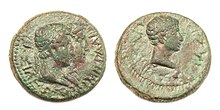
The Thracian kingdom, also called the Sapaean kingdom, was an ancient Thracian state in the southeastern Balkans that existed from the middle of the 1st century BC to 46 AD. Succeeding the Classical and Hellenistic era Odrysian kingdom of Thrace, it was dominated by the Sapaean tribe, who ruled from their capital Bizye in what is now northwestern Turkey. Initially only of limited relevance, its power grew significantly in the ancient Roman world as a client state of the late Roman Republic. After the Battle of Actium in 31 BC, Octavian (later emperor Augustus) installed a new dynasty that proved to be highly loyal and expansive. Conquering and ruling much of Thrace on behalf of the Roman Empire, it lasted until 46 AD, when Emperor Claudius annexed the kingdom and made Thracia into a Roman province.
History
In the late 2nd and early 1st century BC, Thrace was politically fractured and subject to constant fighting between local and foreign powers. At the same time, the Roman Republic tried to exert more influence in the region. The Romans encountered great resistance and suffered repeated defeats at the hands of Thracian tribes, most importantly the Bessi; regardless, the Romans gradually contained the Thracian raiding into surrounding, Roman-dominated areas like the one of ancient Macedon.
By the middle of the 1st century BC, one of the most important Thracian tribes were the Sapaeans; the latter eventually became Rome's allies and clients. However, many Thracians continued to oppose both the Sapaeans as well as the Romans. Around 13 BC, the Bessi under a priest named Vologaesus revolted and killed the Thracian king. The Roman Empire put down the rebellion and consequently expanded its holdings along the Danube. Another unsuccessful revolt broke out in 11 BC.
The power of the Thracian kingdom declined as the royal family became embroiled in dynastic conflicts and civil wars. When Sapaean ruler Rhoemetalces I died in 12 AD, the Romans divided his kingdom among his son Cotys III and his brother Rhescuporis II, but the two rulers quickly started to fight each other. Cotys III was murdered by his uncle in 19 AD, whereupon the Romans deposed him and picked new kings from the two lines. Further rebellions continued to erupt in the Thracian kingdom, such as in 21 AD when insurgents besieged king Rhoemetalces II. He was saved by the Roman army's intervention. In turn, Rhoemetalces II helped the Romans to put down a rebellion among the southern Thracian mountain tribes in 26 AD. Around 44/45 AD, another revolt broke out during which king Rhoemetalces III was killed. In 46 AD, Roman Emperor Claudius put an end to the kingdom by annexing it.
List of Sapaean Kings
- Cotys I (Sapaean), ie. Cotys VI of the Odrysian kingdom, (57-48 BC)
- Rhescuporis I (Sapaean), of the Odrysian Kingdom (48-41 BC)
- Cotys II (Sapaean) ie. Cotys VII of the Odrysian kingdom, (42-15 BC)
- Rhescuporis II (Astaean) of the Odrysian kingdom, son of Cotys II (18-15 BC)
- Rhoemetalces I of the Sapaean kingdom, son of Rhescuporis I (Sapaean), Guardian to Rhescuporis II (Astaean) (15 BC-12 AD)
- Cotys III (Sapaean) of the Sapaean kingdom (Eastern portion), son of Rhoemetalces I and (12-18 AD)
- Rhescuporis II (Sapaean) of the Sapaean Kingdom (Western portion), younger brother of Rhoemetalces I (12-19 AD)
- Rhoemetalces II of the Sapaean kingdom, son of Cotys III (Sapaean) (19-38 AD)
- Rhoemetalces III son of Rhescuporis II with Pythodoris II, sister of Rhoemetalces II (38-46 AD)
References
- Webber 2001, pp. 14–15.
- ^ Webber 2001, p. 15.
- Delev 2016a, p. 49.
- Webber 2001, p. 16.
Works cited
- Webber, Christopher (2001). The Thracians 700 BC – AD 46. Oxford: Osprey Publishing. ISBN 978-1841763293.
- Delev, Peter (2016a). "Between Pharsalus and Philippi. Thrace in the Forties BC". Thracia. 21: 49–59. ISSN 0204-9872.
Further reading
- Delev, Peter (2016b). "Cotys Son of Rhascuporis". Monuments and Texts in Antiquity and Beyond. Essays for the Centenary of Georgi Mihailov (1915–1991). St. Kliment Ohridski University. pp. 119–129. ISBN 978-954-07-4103-1.
- Delev, Peter (2018). "Did a "Late" Odrysian Kingdom ever exist?". Atephanos Archaeological ad 80 annum professoris Ludmili Getov. St. Kliment Ohridski University. pp. 191–196.
- Kolev, Philip (2017). "Bizye. From Tribal Residence to Roman City". Cities in Southeastern Thrace. Continuity and Transformation. St. Kliment Ohridski University. pp. 125–130. ISBN 978-954-07-4275-5.
- Lozanov, Ivaylo (2015). "Roman Thrace". In Valeva, Julia; Nankov, Emil; Graninger, Danver (eds.). A Companion to Ancient Thrace. Wiley-Blackwell. pp. 75–90. ISBN 978-1444351040.
- Matei-Popescu, Florian (2018). "The Thracian strategiae in Scythia Minor". Society, Kings, Gods. In memoriam professoris Margaritae Tachevae. St. Kliment Ohridski University. pp. 107–118. ISBN 978-954-07-4417-9.
- Terziev, Stoyan (2017). "The cities in Southeastern Thrace and the central government under the last Thracian Kings (27 BC—AD 45)". In Daniela Stoyаnova; Grigor Boykov; Ivaylo Lozanov (eds.). Cities in southeastern Thrace. Continuity and Transformation. St. Kliment Ohridski University. pp. 131–140. ISBN 978-954-07-4275-5.